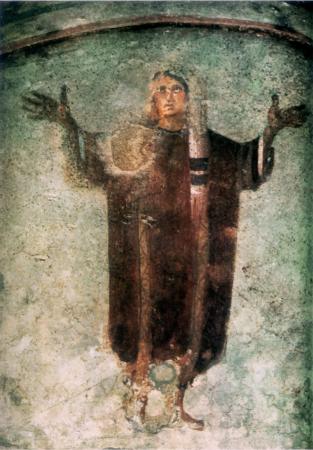
Mural from Catacombs of Pricilla
Published Sunday Next before Advent MMXI
MMVI. Copyright 2011 Order of Centurions |
www.orderofcenturions.org | 11/20/2011
The Ancient Collect
its history and form
Wikipedia on the Collect
We will focus here on two aspects of the collect: Its history and its form.
HISTORY
The Collect form of prayer is formal and distinctively Western in its liturgical use. It was initially simply
referred to as Oratio, meaning "The Prayer". Then later it was referred to as "Collectio" meaning
"collection". Collect has been used as a technical term, and refers to the form and style of the prayer. All
prayers which follow its form are collects. There are different types of collects used. Some are general, and some
are specific to a certain day in the church calendar. Those that are specific were referred to as Proper Collects,
and they were accompanied by specific readings from the Bible (Psalter, Epistle, and Gospel).
The history is obscure. We find the collect written in the ancient books of liturgical worship in the Western
churches, the "Sacramentaries". As to the exact way in which the collect was introduced and became a standard
of the church, we have no specific reference. However, some have speculated on its origin.
The Station Theory
In the early western church the saints would gather on a given day to commemorate a fallen brother, perhaps a martyr
whose remains (relics) had been moved (translated) to a church in the city. The folk would gather at an appointed
place in the city. The one presiding, normally a presbyter or bishop, would then give the salutation and bidding,
and then the "Oratio ad collectum" -- the prayer at the gathering -- "collectionem populi" - gathering
of the people. The assembly would then move in procession to the Station. In a city like Rome, there would be many collections of folk and many processions coming together in the place appointed by the bishop.
The Prayer Collection Theory
In the early books of worship "sacramentaries" there was a specific form where the collect form of prayer and the collect of the day
appears. The celebrant/officiant would ask the people to pray silently for some special reason, and then after their silent prayers were completed, they would stand and the celebrant would give a summary prayer to collect all their prayers together into one eloquent concise concluding public prayer. It follows this form.
Celebrant - salutation - "Dominus vobiscum" -- The Lord be with you
People - response - "et cum spirito tuo" -- And with thy spirit
Celebrant - bid - Oremus, dilectissimi, etc. -- Let us pray...(with a specific request based on the times or
theme)
Deacon - command - "Flectamus genua" -- Let us bend the knees
All - silent prayer kneeling
Sub-Deacon - command - Levate - rise
Celebrant - collect - Upon rising the priest would collect the silent prayers into the one public collect that
featured the theme of the day.
FORM
There is a set five-part structure for the collect prayer. Items may be omitted, but no new ones are added. It
follows here:
Salutation -- to God -- Father, Son, or Holy Ghost, but usually to God the Father. It will also normally have
a characteristic such as "Almighty", "Merciful", or some such qualifier of God's nature.
Attributes -- often which relates to the purpose of the prayer. Often the word "who" is used in the
attribute. Sometimes recounts God's actions before which are meaningful to the theme at hand
Petition -- this is a central part of the collect for it is the matter addressed. What specifically is
requested.
Result -- what the people pray will be the outcome of God's grace, what they are to realize God acts on this
petition.
Termination Normally ended through Jesus Christ. If he has been named within the body of the prayer, one may
also see the term, "the same" "per Christum Dominum nostrum" and also in many cases the doxology naming the
trinity and their unity.
Affirmation "Amen" -Hebrew for "so be it" -- said by all.
We may examine the traditional form of the Prayer of the Order of the Centurions and see this structure.
Salutation-Address
Almighty God, our Sovereign Lord,
Attribute-God's historic acts
who didst call Cornelius the Centurion to be the first Christian amongst the Gentiles, and didst heal the servant
at Capernaum in accordance with the Centurion's great faith, and didst inspire the Centurion at Calvary to glorify
Jesus;
Petition strengthen us in our faith
Result-expected outcome
so that we might follow their example to love, serve, and glorify thee as faithful members of the Church Militant,
Termination through the same Jesus Christ our Lord, who liveth and
reigneth with thee and the Holy Ghost, one God, for ever and ever.
Affirmation by the people Amen.
Example of a bidding and collect from Sacramentarium Gellicanum
The bidding
Let us pray to the Lord God, because calamitous times have come upon us and great perils have drawn near: kingdoms are changing; nations are disrupted; love perishes. Therefore, while there is time, let us turn to the Lord; let us bend our knees; let us humble ourselves before him, let us implore God the Father Almighty, who graciously hears those who call upon him, and who forsakes not those who trust in him.
The Collect
Oh, how great is your compassion, O Lord: in that you succor the captives; pity the wretched and afflicted; are indulgent to sinners; comfort those driven hither and yon; raise up the oppressed; hear the suppliants: To those who have not, give--grant forgiveness to sinners; convert the people to calling on and honoring your name, put in our hearts that mercy which you, O Holy and Merciful God, shower on us; and hear our prayers through the Merits of Jesus Christ, your Son, our Lord. Amen

Published Sunday Next before Advent MMXI
MMVI. Copyright 2011 Order of Centurions |
www.orderofcenturions.org | 11/20/2011